Cwmorthin and Rhosydd Quarries - there and back (7.5km)
Today’s walk is one I’ve wanted to do for a while. It’s a bit further afield for me, being on the outskirts of Blaenau Ffestiniog, and between actual lockdown and feeling like we’re in lockdown with all the visitors to Gogledd Cymru, I haven’t dared venture into the mountains at all. I bit the bullet today though and boy was it worth it. There were waterfalls, stunning views and plenty of derelict buildings to explore. I had originally planned a circular walk, but time got the better of us and as I don’t really know the paths or the area that well, I made the decision to turn back. My mum grew up in the Scottish Highlands and has instilled in me a strong respect for the mountains! Safety always comes first, especially with wee kiddies in tow. I’ll definitely be back for further exploring another time though. On today’s walk was myself, Megan (4yrs) walking and Anwen (13months) in the backpack.
Distance: 7.5km (according to the OS map app)
Time taken: 2hrs 20mins
Total ascent: 392.02m (OS Map app)
Parking: Yes- a couple of free car parks in Tanygrisiau.
Facilities: No, but there’s a cafe just down the road from the car park.
1. Tanygrisiau itself is a bit of a maze of very narrow roads. I had researched beforehand and knew there was a car park near the start of the walk. Despite this I still ended up parking somewhere different! I’ve marked the car parks on the map below, but I recommend you have a study of Googlemaps or something before you set off.
I parked at the lower of the two car parks, by the weir.
To start the walk I headed straight up the road, not crossing over the bridge on the right, and passed through a large kissing gate. As we followed this road I soon spotted where I should have parked on the other side of the river! However, it wasn’t a big deal at all as we weren’t far off and it became obvious which way we should go in order to reach the start of the walk. We could see the waterfall beyond the car park, and in front was a bridge for us to cross the river. There’s a clear path down to the bridge on the right.
Head up to the left rather than crossing the bridge on the right.
Follow the road.
It soon becomes obvious where you should be- on the other side of the river!
Path to the bridge by the waterfall.
Rhaeadr Cwmorthin “rheye adder Coom orth inn”
Once we crossed the bridge we turned left up the track, following the river up. It’s uphill for a little while but soon flattens out. You’ll pass another impressive waterfall on the way. Above this one, you’ll find a stone painted with the words Cofiwch Cwmorthin (Remember Cwmorthin). Today’s example is a reference to the original “Cofiwch Dryweryn” wall, which is a graffitied stone wall near Llanrhystyd, Ceredigion. This design can be found on murals all over Cymru and even the world, with two in the USA. The words were originally painted in the early 1960’s following the decision by the Liverpool City Council to flood the village of Capel Celyn in the Tryweryn Valley in order to create the Llyn Celyn Reservoir, against the wishes of 35 of Wales’ 36 MPs. The “Cofiwch Dryweryn” motto urges people to remember the destruction of a Welsh-speaking community at the hands of Westminster.
Track up from the first waterfall.
“Cofiwch Cwmorthin”
Not long after this you’ll see a strange pyramid sculpture on the other side of the river. On the OS maps the footpath goes to the left here, crossing the narrow bridge just after the pyramid (I think this bridge would once have been part of the Lower Mill building, which is now non existent.). However, by now the path has been blocked off as it’s unsafe so we had no access to the strange sculpture at this stage (we could come back to it once we cross the river further up but we didn’t have time today). According to my research, the Pyramid was created by Robin Jones, a former quarry worker at Cwmorthin. He decided, on his retirement, to create a garden that included some of the tools and equipment used in slate quarrying as a way of reminding people about their past. It’s quite sad to see it in such a state today. Definitely one to visit next time.
Robin’s garden.
Unsafe bridge.
2. This section of the route passes by the lower part of the derelict Cwmorthin Quarry. There aren’t many buildings to see here, but we are surrounded by the old slate tips.
Cwmorthin Quarry
Slate extraction began at Cwmorthin in 1810, when a small quarry was opened on the site by the Casson family who were also working the Diphwys Casson quarry, further to the east. Two of the five Blaenau Ffestiniog slate veins outcropped near where the quarry started, and it is not known whether the early workings were on the Old Vein or the Back Vein, as all evidence has been destroyed by later workings.
After various people worked the quarry, the Cwmorthin Slate Company was formed in January 1861. Outputs from the quarry steadily increased from 350 tonnes in 1862, to 12,500 tons of finished slates in 1876. Some 96,000 tons of slates left the quarry between 1861 and 1876. Based on typical figures for the region, that 1 ton of finished material was produced from 10 tons of quarried rock, this would indicate that around one million tons of rock were extracted during this period. The waste rock was initially tipped around the edge of the two surface workings, known as the North and South Sinks, but was later tipped in a series of terraces to the east of the workings, which eventually covered up the South Sink.
The quarry gained a reputation for poor working conditions and was known locally as “The Slaughterhouse”. Between 1875 and 1893 there were 21 deaths in Cwmorthin out of a workforce of around 550. Following the passing of the Metalliferous Mines Act 1872, all mines were required to keep records of their operations, and to report fatal injuries, some details of the men and boys employed, and the output of the mine. Like many slate mines, Cwmorthin argued that it was a quarry, and that the law did not apply to them. Following a fatal accident in 1875, a test case was brought against them, and the enterprise was deemed to be a mine under the terms of the Act. The company went into liquidation shortly afterwards.
A new Cwmorthin Company was formed in 1876 following the collapse of the original company. To the north of the quarry, on the other side of the Allt-fawr ridge, the Welsh Slate Company, the Rhiwbryfdir Slate Company and Holland’s Slate Company were all working the same veins. They were on land owned by the Oakeley family, and worked under leases, which placed restrictions on how they could be worked and the royalties they had to pay. Cwmorthin was not restricted in this way, because they owned the freehold. On the surface, the boundary between the Oakeley’s Tan-Y-Bwlch estate and the Cwmorthin Isaf estate was marked by cast iron markers. However, below ground, the boundary was less clearly defined, and there were disputes over whether the companies were encroaching on each other’s territory.
Relationships deteriorated later in 1884, when most of the Cwmorthin workings in the Back Vein collapsed. The ground above the workings was fractured, right up to the top of Allt-fawr, where Llyn Bach, which supplied water to Holland’s workings, was drained as a result. The fall had disastrous consequences for Cwmorthin, with production falling from 11,600 tons in 1884 to 6,900 tons in 1886. About half of the mine became inaccessible. In order to develop the quarry further, they had to open new chambers below the level of Llyn Cwmorthin. This was costly, as development work produced little productive slate, and there were additional costs for pumping and for machinery to raise the rock up to the level of the mills. The burden of development was too great, and led to the winding up of the company in 1888. The mine was bought by the New Welsh Slate Company but was once again put up for sale in 1902.
The Oakeley Company had been concerned about the condition of the western end of the mine since 1889, as many of the pillars left between the chambers by the Cwmorthin workings were thinner than normal practice, and they feared another collapse, with the additional risk that the water from Llyn Cwmorthin might enter the workings, causing widespread flooding. In order to safeguard themselves, they bought the operation for £10,000, with little intention of working it. The Lake Mill was demolished and the others were shut up. In 1902 Oakley stripped Cwmorthin of its machinery and allowed the workings to flood, despite the advice of its own consulting engineer. A connecting link was made between the two quarries on floor C in the South Vein. Water then drained into Oakeley’s Middle Quarry. The workings in the North Vein flooded up to lake level and could no longer be inspected.
After the First World War, Oakeley explored reopening Cwmorthin. While the mine had been officially closed for over 20 years, local men had continued to remove slates from the upper workings, and an inspection in the 1920s revealed that much of this part of the mine had been wrecked by rockfalls and was completely unsafe. Productive rock was found in the unflooded underground levels. Although there were supplies of good rock, work in Cwmorthin was hampered by the costs of transporting the finished slates, and by the lack of power. During the Second World War the quarry was mothballed, with only the pumps kept running to prevent flooding. During the 1960s the machinery, where it was still accessible, was removed. In 1970 the main Oakeley Quarries closed and Cwmorthin was sold off separately. Some local men worked it on a small scale, but the scheme failed. A local company reopened the mine in 1995, but all work ceased in 1997.
Just after this section the first big lot of derelict quarry buildings come into view and soon after, the lake. We cross the river near these buildings - a row of old terraced houses known as Tai’r Llyn “Tie r Tlynne” (Houses of the Lake).
Tai’r Llyn
Llyn Cwmorthin with the bridge in the foreground.
Crossing the bridge.
Tai’r Llyn.
Cwmorthin Terrace
Cwmorthin Terrace, later known as Tai’r Llyn, was built by the owners of Cwmorthin Quarry in two stages. The first eight houses were erected in the 1860’s and constructed of dressed stone. A further five, made of slate blocks, were built in the 1870’s bringing the total to thirteen by the 1881 census. The house at the river end used to be licensed to sell tobacco. The combination of fireplaces on show indicate two rooms downstairs - a living room and a kitchen - and at least one grated bedroom upstairs.
Slate quarrymen and their families rented living quarters here. The 1881 census records the names of 72 people who lived in 11 of the cottages. Two cottages were empty on census day. One was later re-occupied but the other, in the centre of the row, seems not to have been used again as a residence. The youngest inhabitant was one month old, the oldest was quarryman Roberts Richards, 59. Not all were directly engaged in quarry work, housekeeping or attending school. One lodger was an unemployed bookbinder, another was an engine driver. An 11-year-old girl was classed as a domestic servant.
By the 1911 census, the terrace was also known as Tai’r Llyn and only three of the cottages were in residential use. In 1935 the last inhabitant, Carwena Elias, moved to nearby Dolrhedyn.
The sanitary arrangement for the slate- built section was a block of five toilets with a single drain. The conditions were so bad that comments were made to the town’s District Council meeting in December 1989 as to the sanitary conditions.
The Cambrian News and Merioneth Standard 3rd Dec 1898 reported:
“The monthly reports of Dr Jones, the medical officer, and Mr Williams, the sanitary inspector, were read showing that 43 cases of infectious disease had been notified during the month, compared with 70 for the previous month, and 52 for the corresponding period last year. The majority of cases were diphtheria cases, the epidemic being prevalent throughout the whole of the district. He desired to call the special and immediate attention of the council to the disgraceful condition of Cwmorthin.”
Councillor Humphrey Roberts was moved to say:
“ We have heard the reports of our medical officer and our sanitary inspector about the disgraceful condition of Cwmorthin. We have received the same reports about the place several times so that it is nothing new to us. The place is in a disgraceful condition owing to the non-clearance of sewage. Must we wait for another 10, 20, or 50 years without remedying the present state of things? Must young children continue to die through our negligence? Yes, I am bold enough to say it is due to our negligence and that we are as guilty of the deaths of these innocent young children as if we had killed them. The sewer was near the house and the sewage was not being cleared.
The chairman said the new Welsh Slate Company had been asked to effect improvements at their houses. Mr H. Roberts said that it was no use asking the company to do something when we ourselves have done nothing. The late manager knew well enough we could not force him to work for this reason. I propose that the main drain be extended there.”
The new system was probably not much of an improvement on the above situation. The drain from the toilets was extended into the leat carrying water from the lake to the Cross Mill situated about half a kilometre away down towards the edge of the cwm. The effluent would be flushed into this leat which took it away towards the mill, eventually over the water wheel and into Cwmorthin River.
The terrace had gardens on the north side sloping towards the lake, and small yards where the privies were located on the south side.
View of Llyn Cwmorthin from Tai’r Llyn.
Inside Tai’r Llyn.
Back to front.
The original stone built terrace.
Inside a cottage.
Looking through the doorway.
Front of the slate built section.
After exploring Tai’r Llyn we continued along the path that goes along beside the lake. Just after the terrace, alongside the path, you’ll find the nondescript remains of the old chapel - Capel Tiberias. I didn’t take any pictures as I hadn’t realised it was anything other than an old outbuilding!
Capel Tiberias
The Independent Congregational chapel was built at the same time as the stone cottages of Tai’r Llyn. It was built at a cost of £100 and completed in 1866. It could seat 100 worshippers.
There are a couple of kissing gates to pass through along the path... some big enough for chunky old me with Anwen on my back, some not! There are gates next to each one which makes life easier, but remember to leave them as you found them. This is lovely, easy walking along this section and a perfect opportunity to take in the atmosphere of this incredible place.
Looking back at Tai’r Llyn.
Walking away from Tai’r Llyn.
Llyn Cwmorthin and Tai’r Llyn.
Path along Llyn Cwmorthin.
Remains of a track.
Remains of a track.
Cwmorthin Uchaf
This old farmstead has the honour of being the earliest known dwelling in Cwmorthin. Many sources have quoted a resident, Sion Jones, as stating a few years before his death aged 100 in the 1860s that his family had occupied the farm for 800 years. The original house would have been a typical one roomed tyddyn with a crogloft, but was extended numerous times over the years.
At the far end of the cwm you might spot the remains of Plas Cwmorthin nestled among some trees - but we’ll get to that later. Before then, on the left of the lane, you’ll see the beautiful remains of the old chapel - Capel Y Gorlan “Cap ell Er Gore lan”
Walking up the cwm.
Looking across the cwm towards Cwmorthin Uchaf.
Capel Y Gorlan in the distance.
Beautiful slate fence.
Capel Y Gorlan
Capel Y Gorlan was a Calvinist Methodist chapel. It has slowly decayed since the slate roof was robbed by thieves in the 1970s. The names Capel Cwmorthin and later Capel Conglog we’re also used but the original name may well have been Capel Y Golan.
Rhian Williams, a local researcher specialising in Methodist history, has recorded the background of this chapel.
“In the West Meirionnydd Presbyterianism Chest (Welsh Presbyterian Church) there is a lease agreement that follows the template of such leases between landowners and local residents who wish to build or extend a chapel during this period. This particular lease, dated the 9th of November 1870, was between John Ralph Ormsby Gore; a large local landowner (including Rhosydd Quarry), MP, living in Oswestry; where the documents were signed, and the trustee for the Welsh Calvinistic Methodist Chapel of Ffestiniog. This was the lease for Cwmorthin Chapel, a branch of Bethel Chapel, Tanygrisiau.
It was a small chapel located above Tanygrisiau in a ‘quiet little nook on the edge of the Moelwynion – with a steep hill one had to climb to it from Tanygrisiau.’ According to history it was built in 1867 but Sunday school had been held in the Cwmorthin Uchaf Farm since 1855. It was placed so remotely, with weather so austere that this chapel was closed for six weeks in 1895. Sunday school was held there in the mornings, with Sermons held in the afternoon.
The Prayer meetings were held every other Tuesday evening, alternating with the Fellowship meetings. It is believed that the chapel was closed sometime between 1929 and 1939, possibly after 1932. Negotiation then took place with Ormsby Gore for the lease of a piece of land, and upon reaching an agreement the Presbyterians called upon many of their ministers (and there were plenty to choose from) and many a local elder to sign on behalf of the union as trustees.”
Capel Y Gorlan with child for scale.
On the OS map the footpath pulls off to the left not long after this but it looked a bit too steep for my liking so we continued on the more obvious path. I was interested in having a look at Plas Cwmorthin anyway, which was off on our right and could be seen clearly from the Capel.
3. We turned right towards Plas Cwmorthin before the gate at the foot of the hill we would be attempting later. There’s a waterfall tumbling down just beyond and the turn is opposite the ruins of the Rhosydd Stables - built in the late 1850s by Rhosydd Quarry to house the ponies used to carry its slates through the valley. The 1871 census notes its use as a barracks. Numerous items have been found in this building including the ironwork of a cart, a curry comb, horse buckles, and a single horse shoe suitable for a Welsh Cob of 14 to 15 hands. Other pieces suggest a carriers cart rather than a slate cart therefore representing a vehicle for bringing supplies and people to Plas Cwmorthin and Cwmorthin Uchaf.
After a brief explore then a rest, we doubled back on ourselves until we got back to the main track, then turned right through the gate and begun our ascent up to Rhosydd Quarry, past the waterfall on our right and the ruins of the Rhosydd “ Rhoss ith” Terrace on the left.
Rhosydd Terrace.
Remains of Rhosydd Stables.
Path to Plas Cwmorthin.
Path to Plas Cwmorthin.
Plas Cwmorthin
Plas Cwmorthin, the Rhosydd Quarry manager’s house, was built in 1860. It has a half-hipped roof and slate-hung end walls, sheltered, like many a manager’s house in the area, by a small plantation of trees. At the end of the garden is a two hole privy. Inside, the Plas had four rooms on the ground floor (one a kitchen with a range), four large bedrooms and one small one, and a basement containing a large oven. The interior walls were mostly thin partitions.
The Plas was supplied with food by pony from Tanygrisiau with large stocks having to be laid in against the snowdrifts of winter. From 1860 to 1932 the Plas was the residence of the Rhosydd Quarry agent. The Williams family moved into one room from Rhosydd Terrace in the late 1930s before moving out of the valley completely in 1948 - the last people to do so.
Lewis & Denton summarise the three quarry agents who lived here:
The agent was the most important man in the quarry, being responsible for the day-to-day running and indeed often shaping long-term policies by his advice to the board. In most quarries except the largest, the agent was a man of the people who had risen to the top by his own merits, and however English the company he was almost inevitably Welsh, since almost all his workmen were too. In all it’s life, from 1853 to 1948, Rhosydd had only three agents.
Thomas Jones - the first was born at Llandwrog in 1815 and gained his practical experience at Cwmmachno Quarry. He served at Rhosydd from 1853 to 1878, when he retired to Porthmadog. He died in 1885. He was clearly a knowledgable and effective manager, a disciplinarian but on excellent terms with his men. In his time, a Rhosydd workman who left would often return before long, sadder but wiser, saying there was no other quarry like it. He was a Methodist deacon, had a sharp wit and a stick he made himself felt with, but also a great sense of humour. He had no truck with “Mr” or “Thomas”, he had to be called Tomos Jones and nothing else; but behind his back his nickname was Hen Ewythr (Old Uncle).
The Plas in its heyday with some of the Thomas Jones family.
William Morris - Born at Tanygrisiau old farmhouse, became clerk at Rhosydd in 1862, then the Rhosydd shipper at Porthmadog, and finally agent in 1875. He retired in 1906 to Penmorfa where he died about 10 years later. He too was a Methodist deacon. We know little of him, except that he must have been competent since in his time Rhosydd reached its peak and so many mechanical advances. But it seems that, at least towards the end of his term, he tended to be cautious and conservative, and thereby perhaps unfitted to meet the crisis of the Great Fall.
Evan Jones - Was an entirely self-made man. Born in 1867, he began his career as a slate maker at was an entirely self-made man. Born in 1867, he began his career as a slatemaker at Maenofferen, then became a rockman and moved to Groesyddwyafon Quarry to the east of Ffestiniog; becoming agent there for a few years before moving to Rhosydd. As agent he was enterprising and energetic, and was defeated not by any shortcomings of Rhosydd or of himself, but by economic facts. After Rhosydd closed he returned to Groes. But he had other interests too. During the First War, with the rank of captain, he commanded a Welsh Miners Tunnelling Company in France and was twice mentioned in dispatches. He vacated the Plas due to the poor health of his daughter Ellen Anne. He was active in local politics: at various times chairman of the Ffestiniog UDC and of the County Council, Sheriff of the county, Deputy Lieutenant, JP; and in 1935 he was knighted for his political work. He died in 1949.
Arriving at the Plas.
Nature has taken over.
Chimneys.
Fireplaces on the ground and first floors.
Fireplaces in the basement, ground and first floors.
Having a shady sit down.
Plas Cwmorthin.
Plas Cwmorthin.
View from the Plas.
Waterfall.
Rhosydd Terrace.
Rhosydd Terrace
The terrace is situated at the far end of the cwm, just below the track leading up to Rhosydd Quarry. They have also been known under the names Tanrallt Rhosydd and Tai Conglog, after that part of the cwm - congl meaning “corner” in Welsh. The Rhosydd Slate Co. built this row of six cottages. The date was almost certainly 1865 - 66 when considerable quantities of building materials for domestic use were imported via the Croesor Tramway; presumably Cwmorthin Quarry was still upholding its ban on wheeled vehicles using its road. Built as basically a one-up one-down set of dwellings the houses were for family use, with the single men barracked above in the Rhosydd barracks. The 1871 census records that each cottage was occupied by a quarryman, his wife, and one, two or three children. Although they are small, they vary in size from 10 feet to 15 feet wide. There is ostensibly only one room per floor but since the ground floor in every case has two fireplaces there was probably a wooden partition. The front doors are on the south and to the north are tiny backyards with, in some cases, remains of outbuildings – perhaps wash houses. The building material is not slate but so-called granite and the chimney on the eastern gable has no fireplace below and appears to be there only for symmetry.
The 1871 census lists 27 persons as living in the six properties that form the terrace. By 1881 this had increased to 41 inhabitants with number six not listed. Incredibly 13 people lived in number one – John Williams and his wife Elizabeth, their six sons and three daughters – and two lodgers! When Conglog Quarry grew up in the 1870s, Rhosydd Terrace, once isolated found itself only a stone’s throw from the new mill, but Conglog closed in 1909 and peace returned. By the 1920s there was only a single family left in residence so they knocked connecting doors between numbers 4 and 5 to spread themselves out.
This next section was a bit of a pull for me, being quite unfit and also carrying Anwen on my back (I’m certainly starting to feel her weight these days!) I was nearly defeated but sheer nosiness kept me going as I really wanted to see what was at the top! The views were spectacular even from halfway up, so there were plenty of stops to take pictures! Even Megan complained she was tired at one point... although she never stopped chatting.
Beginning our climb.
Looking down on Rhosydd Terrace and other ruins of the Conglog’s Mill.
Little legs doing well.
What a view.
Nearly there.
Waterfall and buildings.
Waterfall and buildings.
5. Finally as the track flattened out we found ourselves on the level 9 area of Rhosydd Quarry and it was well worth the pull. I could have spent hours exploring up here, there was so much to see.
At first glance, a whole lot of nothing!
Barracks in the background.
Barracks.
Buildings everywhere.
Between the barracks.
Rhosydd, level 9.
Balancing.
Barracks.
Rhosydd Quarry
As Rhosydd was remote from any major settlements it was normal practice for the quarryman to barrack or lodge at the quarry. They would arrive early on the Monday morning carrying enough food to last through the week. Unlike some of the other Ffestiniog quarries there was no such luxury as a quarryman‘s train. To get to work entailed a hard walk, in all weathers, over rough mountain tracks. The working week lasted until Saturday lunchtime.
Life in the barracks at most quarries was uncomfortable but at Rhosydd conditions were generally considered the worst in the industry. They were overcrowded, damp and squalid, and there were no washing facilities apart from the nearest stream. Several times over the years the quarry was censured by the local Medical Officer of Health. Each warning was met by a slight improvement in conditions but the general states remained bad to the end. However, if the living conditions were poor, the comradeship amongst the men made up for it. In the long evenings discussions on every subject imaginable took place while the Rhosydd Male Voice Choir were famed throughout the area.
The earliest barracks were on level 4 and were probably occupied from 1859 to 1899. The well preserved barracks on either side of the “street“ on level 9 came later, with the southern row being built in the 1860s and the northern side added after 1890. Although it gives the appearance of a street the space between the two accommodation blocks only carried a tramway for tipping rubbish. Over the years the number of men barracking declined. Some men, notably those who lived in Blaenau Ffestiniog, preferring to walk to work each day rather than put up with the appalling conditions. Living conditions for the men with families were somewhat better as the quarry had built terraced accommodation in Cwmorthin (Rhosydd Terrace).
Conditions underground were both primitive and basic, particularly when compared to Rhosydd’s near neighbour - Croesor Quarry - which led the industry in innovation. Electric lighting was a luxury found only in the main tunnels underground and all the actual mining took place using candlelight only. Whereas other quarries had special tunnels for the men to reach the workings, in Rhosydd they had to share the tunnels and inclines with the tramways. Despite all this, the quarry had a very good safety record, immeasurably better than Cwmorthin Quarry – known colloquially as “The Slaughterhouse”.However, one sobering statistic put this in context. From 1876 to 1885 the average lifespan of a Ffestiniog quarryman was only 44 years.
Level 9 surface workings.
Level 9 surface workings.
Rusted machinery.
Level 9 surface workings.
Level 9 surface workings.
Level 9 surface workings.
Rusted wagon.
It was at this point, after some exploring, that I made the decision not to continue on towards Croesor but to turn back. I did however, make a small effort to find the footpath marked on the OS Maps that would come out near Capel Y Gorlan. This led me straight between the barracks and out onto the slate tip. I must have missed the path heading down the hill on the right at some point as we just ended up at a pretty spectacular dead end!
Inside the barracks.
Inside the barracks.
Old tramway onto the tips.
Definitely no footpath here!
Beautiful views over the cwm though.
5. From this beautiful perch, we retraced our steps all the way back to the car. Normally I would be disappointed in myself for cutting a walk short, but Cwmorthin is such a spectacular place that I had no regrets and thoroughly enjoyed walking back through the cwm. I’ll include the pictures I took on the way back to the car.
Took less time to go down!
Waterfall.
Tunnel under the path.
Tunnel under the path.
Our dead end was at the top of that slate tip.
A poem on the gatepost to Plas Cwmorthin about characters from Gwalchmai on Anglesey.
Ffrindiau.
Anwen livin’ the dream.
Back to Llyn Cwmorthin. (The trees on the far end are the location of Cwmorthin House- the Cwmorthin manager’s house... one for another day.)
Having a rest.
Back to Tai’r Llyn.
Over the bridge.
Cwmorthin.
Smelling the flowers.

Contrast.















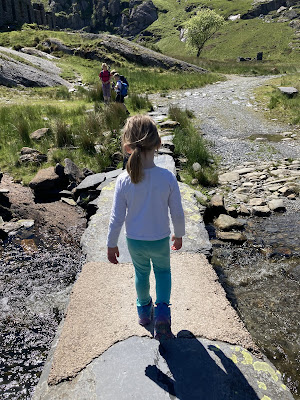

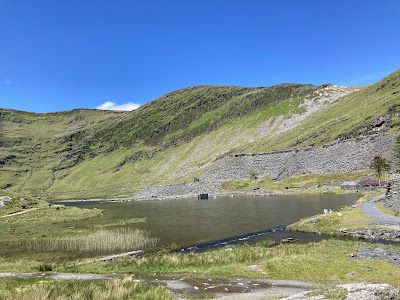


















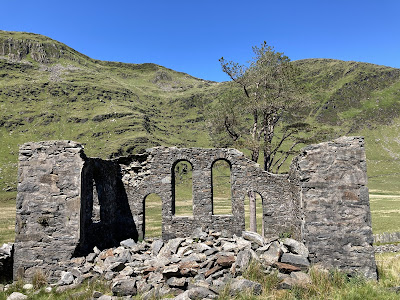






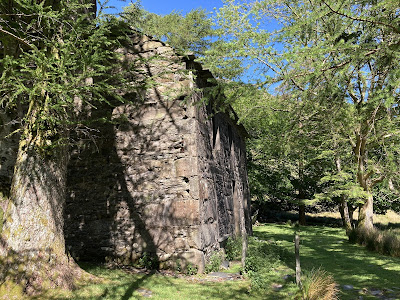










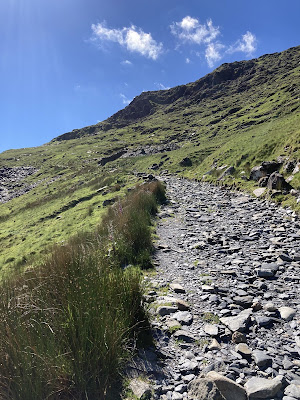








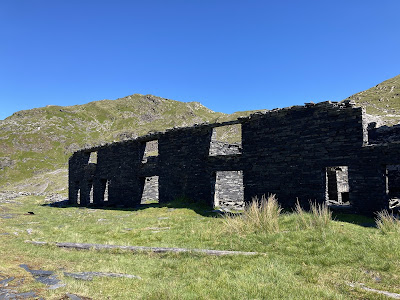









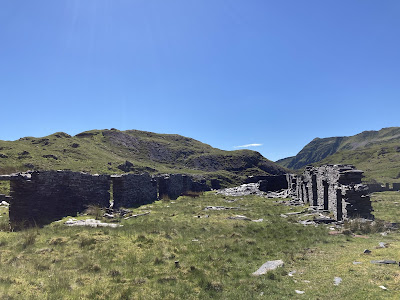




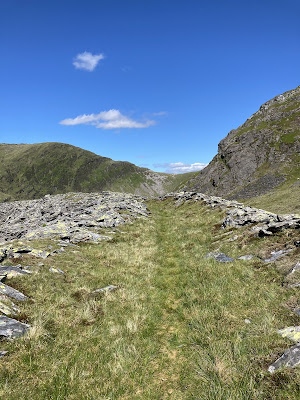





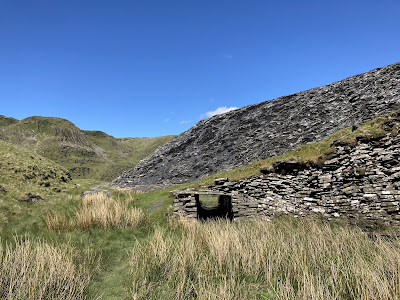













Comments
Post a Comment